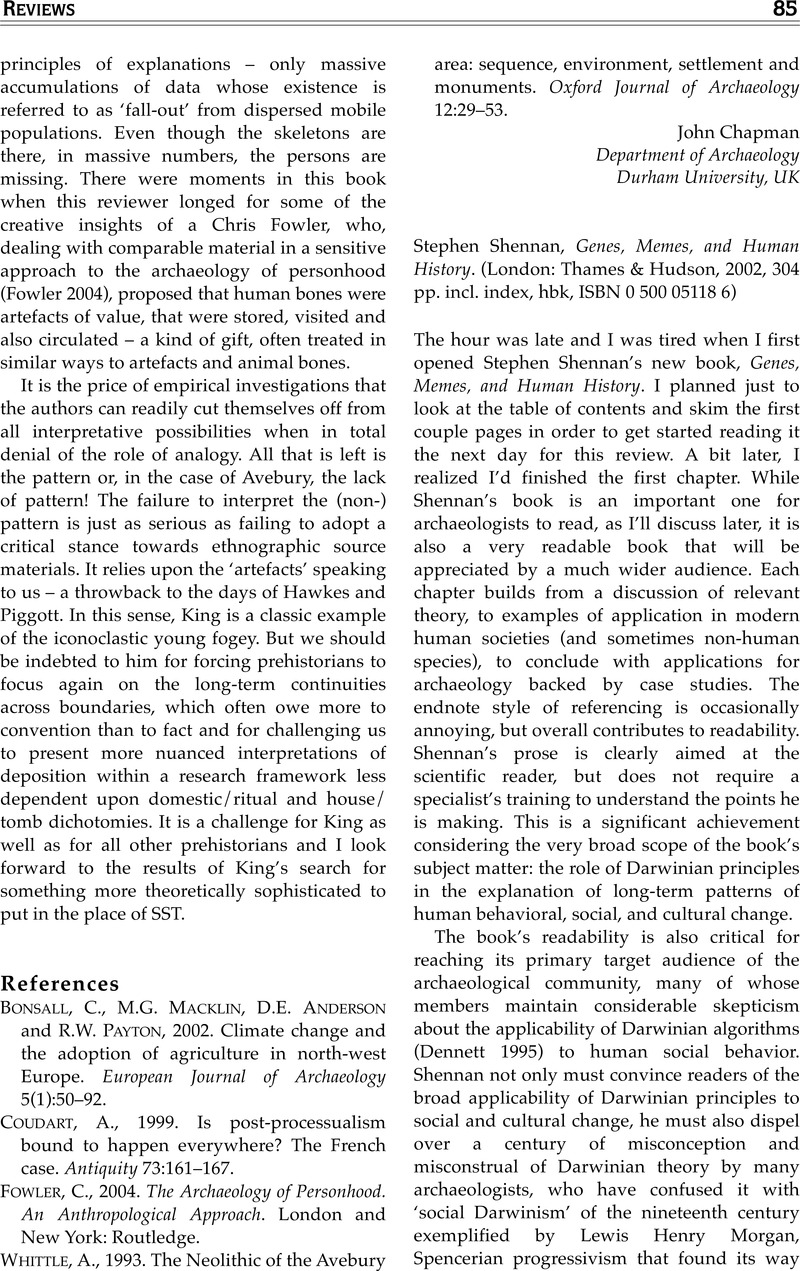No CrossRef data available.
Article contents
Stephen Shennan, Genes, Memes, and Human History. (London: Thames & Hudson, 2002, 304 pp. incl. index, hbk, ISBN 0 500 05118 6)
Published online by Cambridge University Press: 25 January 2017
Abstract
An abstract is not available for this content so a preview has been provided. Please use the Get access link above for information on how to access this content.

- Type
- Reviews
- Information
- Copyright
- Copyright © 2004 Sage Publications
References
Barton, C.M. and Clark, G.A., 1997. Evolutionary theory in archaeological explanation. In Barton, C.M. and Clark, G.A. (eds), Rediscovering Darwin: Evolutionary Theory in Archaeological Explanation:
3–18. Washington, DC: American Anthropological Association (Archaeological Papers of the American Anthropological Association).Google Scholar
Bentley, R.A. and Maschner, H.D.G., eds, 2003. Complex Systems and Archaeology: Empirical and Theoretical Applications. Salt Lake City: University of Utah Press.Google Scholar
Bettinger, R.L., 1991. Hunter-Gatherers: Archaeological and Evolutionary Theory. New York: Plenum Press.Google Scholar
Bettinger, R.L. and Richerson, P.J., 1997. The state of evolutionary archaeology: evolutionary correctness, or the search for common ground. In Maschner, H.D.G. (ed.), Darwinian Archaeologies:
221–232. New York: Plenum Press.Google Scholar
Boyd, R. and Richerson, P.J., 1985. Culture and the Evolutionary Process. Chicago, IL: University of Chicago Press.Google Scholar
Boyd, R. and Richerson, P., 1988. An evolutionary model of social learning: the effects of spatial and temporal variation. In Zentall, T.R. and Galef, B.G. (eds), Social Learning: Psychological and Biological Perspectives:
29–48. Hillsdale, NJ: Lawrence Erlbaum.Google Scholar
Clark, G.A. and Barton, C.M., 1997. Rediscovering Darwin. In Barton, C.M. and Clark, GA. (eds), Rediscovering Darwin: Evolutionary Theory in Archaeological Explanation:
309–319. Washington, DC: American Anthropological Association (Archaeological Papers of the American Anthropological Association).Google Scholar
Cowan, G.A., Pines, D. and Meltzer, D., eds, 1994. Complexity: Metaphors, Models, and Reality. Reading, MA: Addison-Wesley.Google Scholar
Cowgill, G.L., 1975. On causes and consequences of ancient and modern population changes. American Anthropologist
77:505–525.CrossRefGoogle Scholar
Dean, J. S., 2000. Complexity theory and sociocultural change in the American Southwest. In McIntosh, R.J., Tainter, J.A. and McIntosh, S.K. (eds), The Way the Wind Blows: Climate, History, and Human Action:
89–118. New York: Columbia University Press.Google Scholar
Holling, C.S., 2001. Understanding the complexity of economic, ecological, and social systems. Ecosystems
4:390–405.Google Scholar
Kelly, R.L., 1991. Sedentism, sociopolitical inequality, and resource fluctuations. In Gregg, S. (ed.), Between Bands and States:
135–158. Carbondale, IL: Center for Archaeological Investigations, Southern Illinois University (Occasional Paper 9).Google Scholar
Kelly, R.L., 1995. The Foraging Spectrum: Diversity in Hunter-Gatherer Lifeways. Washington, DC: Smithsonian Institution Press.Google Scholar
Lyman, R.L. and O'Brien, M.J., 2000a. Chronometers and units in early archaeology and paleontology. American Antiquity
65:691–707.Google Scholar
Lyman, R.L. and O'Brien, M.J., 2000b. Measuring and explaining change in artifact variation with clade-diversity diagrams. Journal of Anthropological Archaeology
19:39–74.Google Scholar
Nowak, A. and Latane, B., 1994. Simulating the emergence of social order from individual behavior. In Gilbert, N. and Doran, J. (eds), Simulating Societies:
63–84. Guildford, England: UCL Press.Google Scholar
O'Brien, M.J. and Lyman, R.L., 2000. Evolutionary archaeology: explaining historical lineages. In Schiffer, M.B. (ed.), Social Theory in Archaeology:
126–142. Salt Lake City, UT: University of Utah Press.Google Scholar
O'Brien, M.J., Lyman, R.L.,Saab, Y., Saab, E., Darwent, J. and Glover, D.S., 2002. Two issues in archaeological phylogenetics: taxon construction and outgroup selection. Journal of Theoretical Biology
215:133–150.Google Scholar
Redman, C.L. and Kinzig, A.P., 2003. Resilience of past landscapes: resilience theory, society, and the longue durée. Conservation Ecology
7:14 [online at http://www.ecologyandsociety.org/vol7/iss1/index.html].Google Scholar
Smith, E.A., 2000. Three styles in the evolutionary analysis of human behavior. In Cronk, L., Chagnon, N. and Irons, W. (eds), Adaptation and Human Behavior:
27–46. New York: Aldine de Gruyter.Google Scholar
Van Der Leeuw, S. and Redman, C.L., 2002. Placing archaeology at the center of socio-natural studies. American Antiquity
67:597–605.Google Scholar
Winterhalder, B. and Smith, E.A., 1992. Evolutionary ecology and the social sciences. In Smith, E.A. and Winterhalder, B. (eds), Evolutionary Ecology and Human Behavior:
3–24. New York: Aldine de Gruyter.Google Scholar
Winterhalder, B. and Smith, E.A., 2000. Analyzing adaptive strategies: human behavioral ecology at twenty-five. Evolutionary Anthropology
9:51–72.Google Scholar




